At 11tegen11, video scouting is a crucial and indispensable part of our digital scouting process. Once our data profiles flag a player as potentially interesting, we use extensive video scouting to evaluate him thoroughly. For us, video scouting is the ideal connector between data analysis and live scouting. In this article, we explain why video scouting is such a vital tool for us, why we think the initial video evaluation is best done by us, how we use WyScout for video scouting purposes, and which tactical references we use to assess a player’s qualities.
Video scouting
In this article, we’ll write about several key elements of our video scouting process. If you’d like to scroll down to one of the main subjects immediately, you can use the links below.
- How we consider video as an indispensable link between live scouting and data analysis.
- The way we select the most relevant events from several matches using WyScout.
- The possible outcomes of a video evaluation and its consequences.
- Which tactical references we derived from the game to evaluate players.
Indispensable
From the first digital scouting assignment we carried out years ago until our present-day workflow, we have never compiled a shortlist without performing extensive video scouting. There are several reasons why we rely so much on video to improve our player scouting.
Success rate
- Compared to suggesting players based on data only, an added layer of experienced and well-structured video scouting significantly increases the chance that the club rates the suggested players highly. This means the club’s resources will be spent on players deserving that attention and not wasted on players that turn out not to be potential transfer targets. The main reason that video scouting adds value? Data simply fails to capture several crucial player skills. Video scouting is the optimal tool to fill in these gaps.
External feedback
- We place a lot of value on feedback on the quality of the player suggestions. Because of the integrated data and video evaluations, we get very clear picture of their main strengths and weaknesses and their style of play. This makes the communication between the club and 11tegen11 very focused, and it improves our ability to process the feedback. Extensive video scouting enables us to communicate with the club in pure football language within the context of the club.
Internal debate
- Independent of the communication with the people at the club, we also regularly discuss players within 11tegen11. Debating about players is the best way to look at them from different perspectives. It really helps us to improve the success rate of the players flagged from our data analysis. From these debates, we constantly find small angles to improve our data analysis and the subsequent video scouting process.

WyScout events
To evaluate players, we use the platform WyScout. We do not watch full matches, but focus on selected clips of individual players. The reason for that is simple: we scout players, not matches or teams. A club can have several reasons to watch full matches, but for us, this is much less efficient.
Usually, our first evaluation of a player takes about 20 minutes of video time. Every clip lasts approximately ten seconds. Taking into account that we watch some clips two or three times, we are able to watch around 80-100 clips of a player. We want those clips to show as much relevant information about a player as possible. That’s why we use the Custom Video Report option to select the most significant events of a player.
Most relevant events
Obviously, we select different events when video scouting a striker compared to a fullback. Throughout the years, we’ve learned a lot about every single event in WyScout and its relevance for evaluating players.
For example, the event ‘Interceptions’ seems relevant at first, but most of the times it isn’t. In WyScout, even players who barely change the direction of a pass are ‘rewarded’ with an interception. Most of the times, we don’t consider this event to be relevant enough to select.
On the other hand, events such as Under pressure, Tackles, Covering Depth, Dribbling, Through passes and Balls lost provide a lot of information about a player. When compiling a list of clips, we try to include a lot of clips that are very relevant.
Video evaluations
The first evaluation in our video scouting process can have three possible outcomes.
- (1) The video scout thinks the player is not good enough for the club we work for. He strongly doubts he ever will be. Therefore, we do not evaluate this player again, unless his data improve significantly.
- (2) The video scout does not think we should suggest this player to the club at this point. On the other hand, he does think this player could be interesting in the future, depending on his development. Therefore, we schedule a new data and video evaluation four to six months from now.
- (3) The video scout thinks the player could be good enough for the club. He asks someone else to evaluate him.
Consequences
When (3) happens, another video scout evaluates the player within a week. Once again, his evaluation has one of the three possible outcomes listed above. When (3) occurs again, a third video scout evaluates the player, again within a week. When he’s positive too, we put the player on the shortlist that we send to the club.
In other words, when we suggest a player to a club, he has received four positive evaluations. The first one from his data profile, and then three more from our video scouting process. By that time, we have watched 240 to 300 clips, showing the most relevant events for a player. This leads to a very high success rate of the players on the shortlist that we deliver to the club.

Tactical references
All our video scouts have a lot of freedom to establish their own independent opinion about a player’s level. In fact, we actively encourage that. At the same time, their opinion has to be supported by clear, factual and understandable arguments.
By using an explicit explanation why a player is or isn’t interesting for the club, the information is transferred much better than when video scouts refer to catch-all concepts. It can be tempting to use vague terms, with multiple possible definitions, to avoid having to be very specific and potentially expose yourself. At 11tegen11 we put a lot of emphasis on clear and open communication in a safe environment.
Using clear and universal language is only possible for our video scouts if there is a clear tactical framework available to describe the strengths and weaknesses of a player. This is something that we have put a lot of thought into in the last couple of years, and something that we will keep improving and specifing further. In short, we use a few different concepts to describe players’ fit for the club.
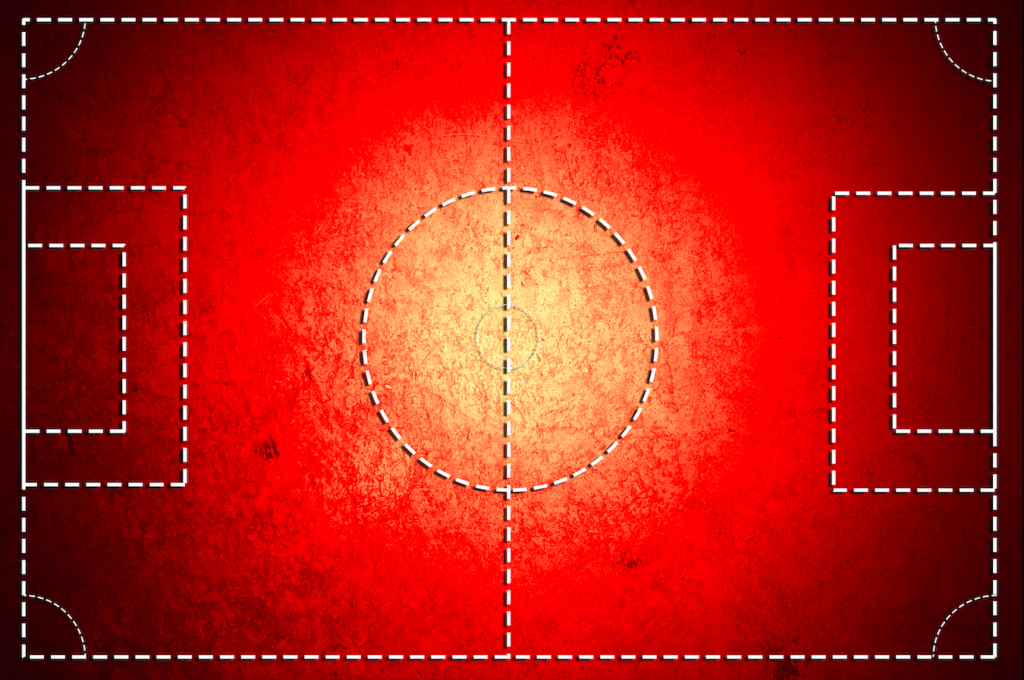
1. Football actions
The first one is the fact that every football action (such as a pass, deep run or defensive 1v1) consists of three consecutive steps: collecting information, making a decision and executing the decision.
A) Collecting information
In the image below, Lasse Schöne does not turn into the open space in front of him because he does not know that is possible. In this situation, he should have collected the required information by adjusting his body position or by checking his shoulder before receiving the pass.
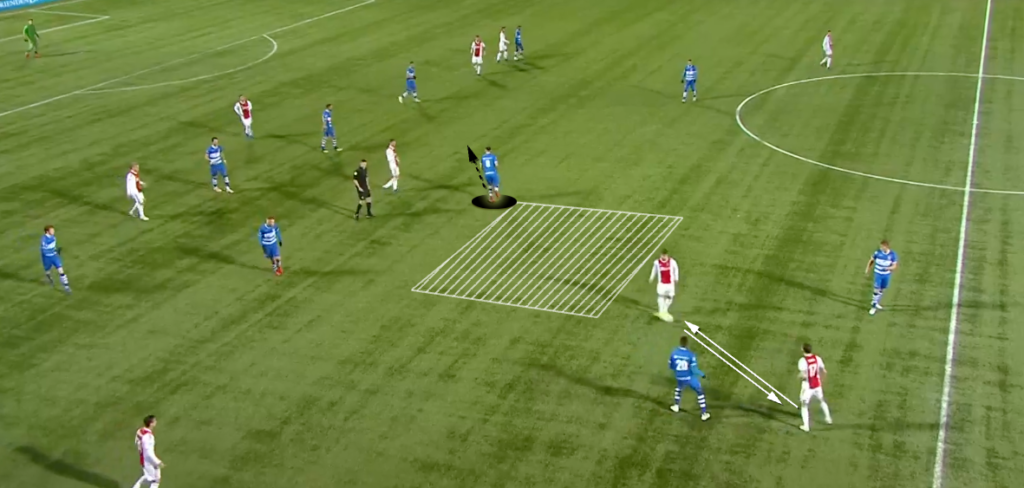
B) Making a decision
In the situation below, Christopher Nkunku could have created a four-on-three situation by dribbling diagonally towards the center of the pitch instead of passing. Instead, he goes for a ball through the air towards Angeliño. The pass itself was executed perfectly, but the decision he made wasn’t the best possible one.
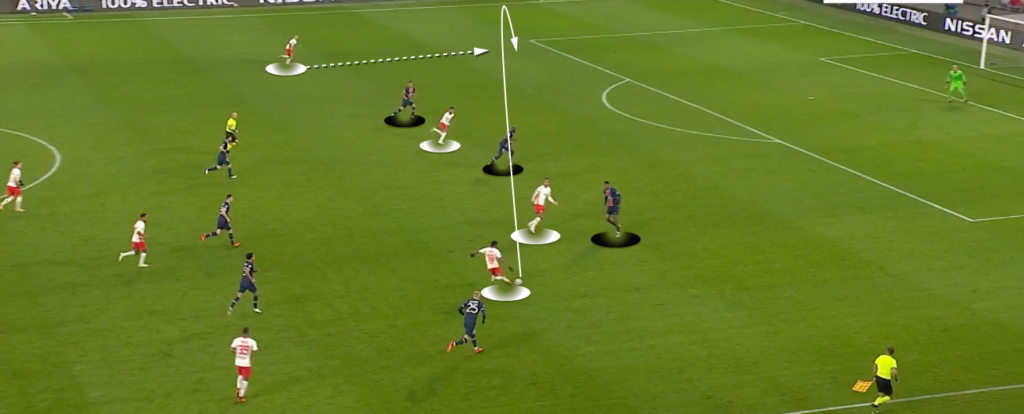
C) Executing the decision
In the situation below, Hee-Chan Hwang sees Patson Daka in a good position (collecting information), chooses the correct moment for the pass (making a decision), but the accuracy was sloppy. More specifically, the direction of the pass was inaccurate (more about that below). It was pointed too much to the left, and as a result, the defender was able to intercept the pass.
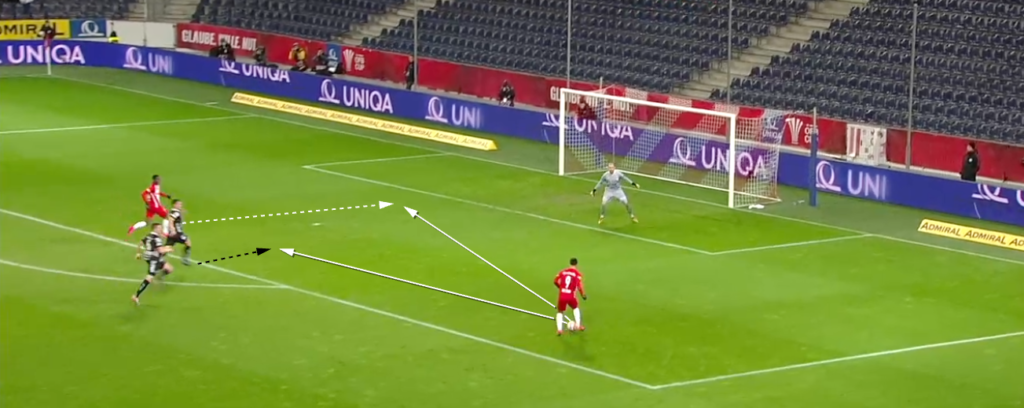
In many situations, it can be very useful to split (A) collecting information, (B) making a decision and (C) execution. This helps to get a clearer picture of what a player does and doesn’t perform well.
2. Position-moment-direction-speed
At the same time, every football action contains four time and space characteristics: a starting point, moment, direction and speed. In the image below, Instituto forward Damián Arce tries to find his teammate with a through pass.
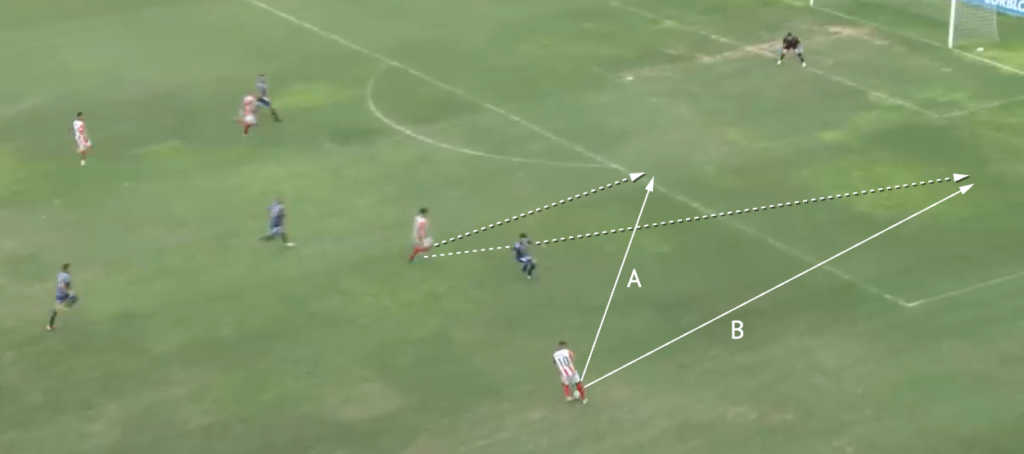
- The starting position of his pass is good. He makes a perfect angle without being too close or too far away from the defender and his teammate.
- The moment is very good too. His teammate is just about to cross the offside line when the ball leaves Arce’s foot.
- The direction of the pass (B) is very weak, though. His teammate would be in a one-on-one situation with the goalkeeper if the pass was directed more to the left.
- For passing option B, the speed of the pass was good. But passing option A would have required a different speed, which we can’t evaluate because it didn’t happen.
Those distinction are very helpful to indicate the strengths and weaknesses of a player. They can be used for every football action, such as a cross, a deep run and a tackle.
Game insight and technique
Let’s get back to the difference between decision-making and execution. Without asking him, we can’t really know whether Damián Arce intended to execute passing option A or B. If he tried B, the decision was poor and this tells us something about his game insight. If he tried A, his execution was poor and this tells us something about his passing technique. The next step would be to evaluate many more clips of Arce and then draw conclusions.
3. Efficiency
A third concept to assess a player’s qualities using video scouting is by looking at his efficiency. This word is mostly associated with goals and assists, but here we are referring to a much more sophisticated concept.
For every football action, we evaluate the ‘result’ of a players’ football action, corrected for the difficulty of the situation. In other words: does a player create better situations? Is the situation for his team better after his football action than just before? Better situations can be create in many different ways.
- Gain ground with a dribble into open space in front of you.
- Push the ball-carrying opponent away without making a foul.
- Block passing lanes towards the centre to force the opponent to the outside.
- Play a bounce pass to a third man who has play in front of him.
- Provoke a foul to win valuable time when defending a lead.
The hallmark of good players is simply that they consistently create better situations.

Get in touch
Video scouting is only one of the resources we use in our digital scouting services. By combining video scouting with advanced data analysis, using self-developed metrics for different player profiles, our support can be really helpful for any club.
If you want to get to know us better, or learn more about how we can support the scouting team within your club, feel free to contact us. We are happy to get in touch through a 30 minute video call and explore ways we could cooperate.




